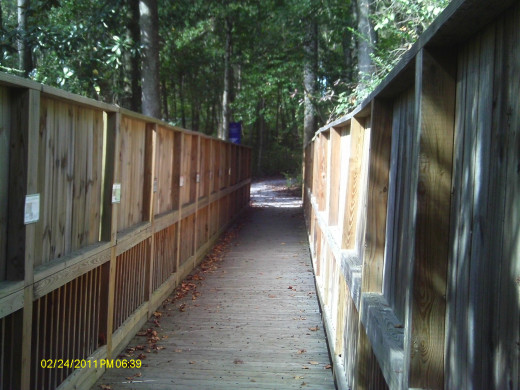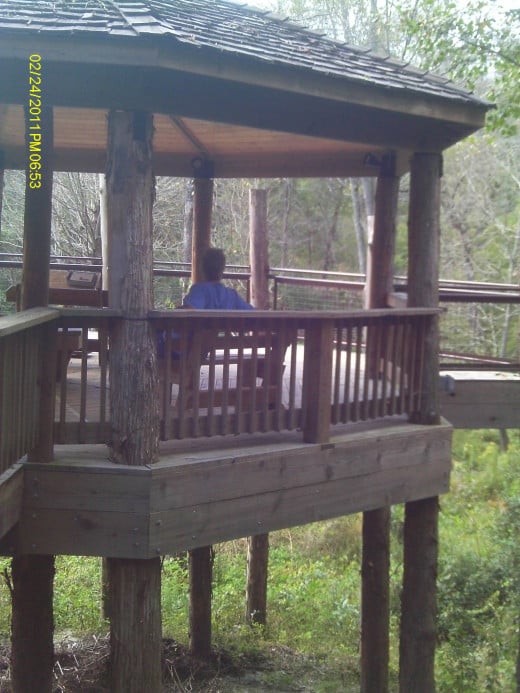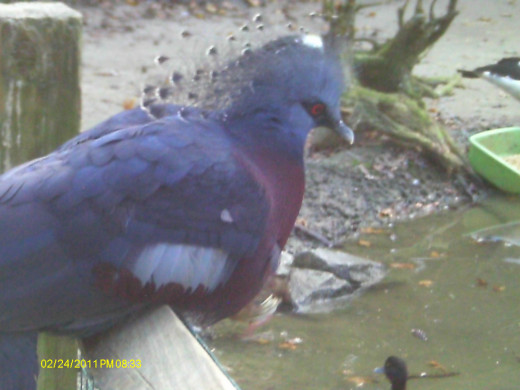Where to Go in North Carolina: Sylvan Heights Wildlife Bird Sanctuary in Scotland Neck
A 5 Star Rating for this gem.
Why I recommend the Sylvan Heights Waterfowl Park
Delightful is the one word I would use to describe the Sylvan Heights Waterfowl Park in Scotland Neck, North Carolina. Although my family and I have only been there twice it has been a wonderful experience both times. I strongly recommend any visitor who happens to be in the eastern area of the state to stop at this gem. I guarantee that you will not regret spending an hour or two there. On all accounts I rate this five stars and only wish I could give it a higher rating.
My father introduced me to this wildlife bird sanctuary in 2007, one year before he died. My friend and I joined him, and my nephew J, for a very educational and enjoyable experience. Dad had discovered it in the way he usually discovered interesting places to visit-through reading about it in the newspaper. He decided it was a ‘must see’, and boy, was he right.
This visit was a bit of bittersweet remembrance of our former trip with dad. This time we went in the fall, the same group minus dad, although he most certainly was with us in spirit. Our admission was a good deal we had gotten from a Groupon coupon-a two for one rate. Comparatively, it is about the cost of a movie ticket and so much more pleasurable.
About the staff
The staff at the waterfowl park is friendly, knowledgeable, and looking for opportunities to give visitors educational moments. For instance, we no sooner bought our tickets and a $2.00 bag of bird feed, than the ticket agent directed us to an event she suggested we wouldn’t want to miss. Two staff were meeting in the parking lot with a red-tailed hawk and guiding it on a tethered flight. We returned to the parking lot, me with my video camera ready, and were not disappointed. After the bird was ‘exercised’, the young man came up to the small group on the porch and asked if we wanted to see the bird up close. It was a picture perfect moment. Note the first video at the beginning of this article-the Red-Tailed Hawk.
Red-Tailed Hawk

Founder of Sylvan Heights Waterfowl Park:
Mike Lubbock, founder of Sylvan Heights, is a native of England. When he arrived in North Carolina it was his goal to continue the ornithology work he had been involved with in England and around the world. The center was established in 1985 but only became a public entity in 2006. In the meantime, Lubbock is world renowned for his work and has received 17 awards for World First Breeding; 15 awards for First Breedings in North America; the Jean Delacour Avicultural Award and has been inducted into International Wildlife Waterfowl Association Hall of Fame.
Bird Watching Tools:
For the Bird watcher:
Important Questions about the Park:
Hours of Operation:
Closed on Mondays and Holidays
Tues-Sun 9 a.m.- 5:00 in the spring-fall; closes at 4:00 in winter months.
Cost of admission:
Adults-13 and older = $9
Seniors = $7
Age 3-12 = $5
Under 3 = Free
Bird Eggs
Click thumbnail to view full-size






Taking the Tour of the Bird Sanctuary
The Sylvan Heights Waterfowl Park actually has the largest collection of waterfowl birds in the whole world. Their mission is to educate people on the importance of conservation of wetlands, wildlife and, of course, birds. There are over 2000 varieties of birds from all over the world. Five continents are represented at Sylvan Heights: North and South America, Eurasia, Africa and Australia.
Within the beautiful log cabin building is a conference room for educational meetings; a gift shop; bathrooms and a display of various eggs: ostrich, emu, and owl were a few. The back door leads into the park and the first thing that greets you is a wonderful pond. Large pictured display boards identify each resident that paddles by and a perpetual fountain keeps the water fresh and moving.
No matter which direction you start in it will eventually lead you into a circle so it is impossible to miss anything if you stay on the path. There were three offshoots to the main track, which we followed when we got there. One was a Beaver Pond Blind, another was the Bird Nest Tree House, and the third was the Kiptopeke Walkway; all overlook wetlands. I remember the park in 2007 and it was only half the size it is now. Back then they were only talking of plans for the tree house, but now they are spread over 18 acres of woodland, ponds and gardens.
While one can make arrangements for a tour guide this is usually a self-tour. It can easily be completed in an hour and half, if one wants to walk quickly through the park, or perhaps just go directly to a particular exhibit without stopping to visit the other areas, however, you would not have time to read the exhibit boards or really get the full impact of the park. We took a leisurely afternoon, the guys patiently waiting for me as I jotted notes and took photos, and finished the tour in three hours. The path is wide enough to accommodate wheelchairs and, if one is so inclined, golf carts are also available for use.
Along the paths there are benches to pause at, and two picnic areas. While snacks and bottled beverages can be purchased in the gift shop, food from home is allowed and there is even a playground area for the kids to get rid of a bit of energy.
Sarus Cranes
One of the highlights of the walk was getting to meet Scooby-Doo. Scooby-Doo is a baby Sarus Crane who was out on one of his walks with staff. As my nephew and I stopped to film the big baby bird, the staff member assured us that he’d be close enough to almost touch, and he was right. I not only was able to find out more information, but also had a great time filming this long legged bird. J and I discovered that there were three Sarus Cranes born at the park, and they will reach a height of six feet tall. Their wing- span will be over nine feet wide, and in fact, they are the tallest flying bird in the world.
Scooby Doo, the Baby Sarus Crane
Flamingos
Flamingos
Did you know that baby flamingos have gray feathers when they are first born? The feathers eventually change to their adult color. There are only six species of flamingos recorded in the world and at least two of these, the Chilean Flamingo and the Lesser Flamingo, are on exhibit at the waterfowl park. I remember when we saw them in 2007 and dad, who always had a good sense of humor, told everyone to strike their best flamingo pose while I snapped a photo. This time I was able to catch them on film.
Exotic Birds
Peafowl and Pheasants
One of the areas I enjoyed the most was that of the peafowl and pheasant exhibits. Although the sign directed me to the names I was still a bit confused on some of the peacocks there. With a bit more research I found that the ‘white’ peacock actually is a Silver Pied Peacock. I would have loved to see any of the peacocks’ feathers open, but they weren’t cooperating that day. In the meantime, it was a joy to see the beautiful colors in the peafowl, the golden feathers of the Golden Pheasant, also known as the Chinese Pheasant, and the Lady Amherst Pheasant, who was named for the wife of the Governor General of Bengal, back in the 1800’s.
Ducks and Geese
Click thumbnail to view full-size



Other Birds
Owls, swans, parrots, Macaws, Kookaburras, Toco Toucans, turkeys, and a Roadrunner are some of the other birds we saw, to name just a few. We saw so many beautiful birds, some seemingly common, like the ducks, but each one special because they represented all parts of the world; some more entertaining for us, like the Emu from Australia, who ‘sat down’ in front of us for several minutes. It was hilarious and we had never seen a bird do that before, or the Buick Goose, who kept honking like a horn; some were more exotic like the Toco Toucan, or the Blue Crowned Pigeon, who had an irritable temperament, but they were all amazing.
Water Birds
Macaws
Photos of the Beaver Pond Blind, Bird Nest Tree House, and Wetland Bridge Kiptopeke
Click thumbnail to view full-size









Wetlands and Caged Birds
After we met Scooby-Doo, the baby Sarus Crane, we continued on our walk and came to a building that housed an exhibit of poisonous frogs and a honeybee comb. We followed the path all the way to the end and it led to the Beaver Pond Blind. Although we didn't see any wildlife through the blind we spotted a lizard on the way out and took a few photos of it. We actually saw many of them as we continued to follow the path through the woods that led to the treehouse.
I have a passion for trees and a fascination for tree houses. Although this tree house was very basic it was fun to have an opportunity to overlook the wetlands from the height of where we stood. The other great thing about it is that it is wheelchair accessible. After several minutes of viewing the area and taking photos we were ready to move on.
We merged back to the main path and followed the exhibits past the geese, the flamingos, and to a large owl cage. It was very difficult to see inside the cage because it was so big and the two birds were on the highest peak. In fact, because of the distance and lack of light going into the cage I knew it was a futile project. If I wanted to get a good photo I had to make a decision.
As I stepped off of the path and towards the bars of the cage I heard my nephew let out a loud gasp. I reassured him that everything was okay and I just needed to get close enough to the cage, but I wasn't in any danger. I snapped a couple of pictures and took some video shots before moving onto the Emu. I felt sorry for the owls; it didn't seem right to have such wild creatures caged up and away from their natural habitat, but I realize it is the same for any of the exotic birds. The waterfowl were the only ones that seemed to be at home in the park.
Beautiful Birds
Click thumbnail to view full-size














A visit to five continents
Although it seems cruel to cage birds up as they are at the park, the founder, Michael Lubbock, is a conscientious conservationist who's mission is to educate others about the importance of caring for species that are endangered. All of the cages are kept clean; the birds are provided with the proper diet; and special programs are available for teachers and students on school field trips.
Lubbock also works with zoo managers and wild life specialists to update them on new techniques on providing the proper environment for the birds. He takes interns from surrounding areas and provides the learning experiences through the husbandry and hatchery projects that have been established.
The design of the park is laid out to enhance the learning experience. Each area represents one continent and the birds that are native to that region are housed in the same vicinity. In this way the visitor sees first hand the types of birds that would commonly be observed and can associate the species with the region.
As we finished our visit we felt that we had spent ample time visiting all of the exhibits, feeding the birds, and enjoying their antics while listening to their calls. It is definitely not a quiet walk through the park, but truly an amazing journey.
Bird species and the continent they are from:
North America
| South America
| Eurasia
| Africa
| Australia
|
|---|---|---|---|---|
Hawaiian Goose (NeNe)
| Black Necked Swan
| Barn Owl
| West African Crowned Crane
| Black Swan
|
American Wood Duck
| Scarlet Macaw
| Golden Pheasant
| African Grey Parrot
| Emu
|
Trumpeter Swan
| Toco Toucan
| Lady Amherst Pheasant
| Lesser Flamingo
| Kookaburro
|
Snow Goose
| Sun Conure
| Blue Crowned Pigeon
| Egyptian Goose
| Umbrella Cockatoo
|
Mountain Quail
| Chilean Flamingo
| Indian Blue Peacock
| Lady Ross Turaco
| Australian Brush Turkey
|
How much did you learn about the Waterfowl Park?
view quiz statisticsWildbird Sanctuary Location:
Sylvan Heights Bird Sanctuary














































